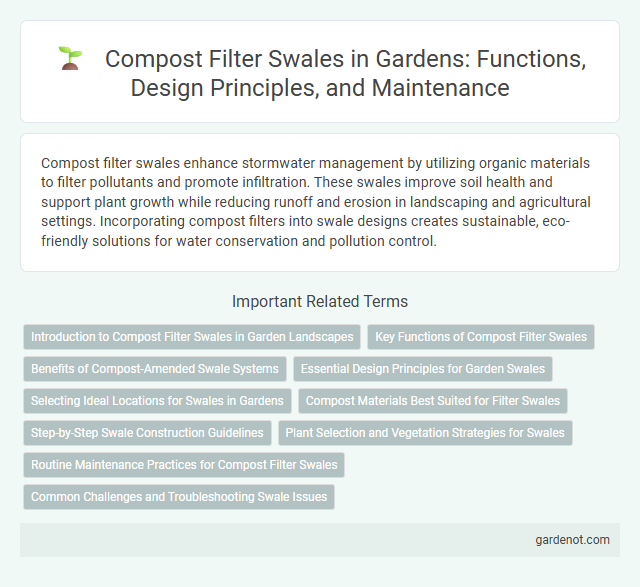Compost filter swales enhance stormwater management by utilizing organic materials to filter pollutants and promote infiltration. These swales improve soil health and support plant growth while reducing runoff and erosion in landscaping and agricultural settings. Incorporating compost filters into swale designs creates sustainable, eco-friendly solutions for water conservation and pollution control.
Introduction to Compost Filter Swales in Garden Landscapes
Compost filter swales are sustainable landscape features designed to manage stormwater by filtering runoff through nutrient-rich compost media. These swales improve water quality by trapping sediments and pollutants, while promoting groundwater recharge in garden landscapes. Implementing compost filter swales reduces soil erosion and supports healthy plant growth through enhanced moisture retention and organic matter incorporation.
Key Functions of Compost Filter Swales
Compost filter swales play a critical role in managing stormwater runoff by filtering pollutants and sediments through layers of compost, which enhances water quality and supports soil infiltration. They reduce erosion by slowing water flow and promoting percolation, thereby protecting downstream ecosystems from contamination. The organic matter in compost provides a habitat for beneficial microorganisms that further decompose pollutants and improve nutrient cycling within the swale.
Benefits of Compost-Amended Swale Systems
Compost-amended swale systems enhance soil structure and increase water infiltration, reducing surface runoff and erosion significantly. These swales promote nutrient retention and support beneficial microbial activity, leading to improved vegetation health and biodiversity. The integration of compost not only improves stormwater management but also aids in carbon sequestration, contributing to sustainable land management practices.
Essential Design Principles for Garden Swales
Compost filter swales enhance water infiltration and pollutant removal by integrating organic compost layers into swale design, improving soil health and vegetation growth. Key design principles include sizing the swale for expected runoff volume, using well-decomposed compost to maximize filtration efficiency, and ensuring gentle slopes for optimal water retention and absorption. Proper placement of plants adapted to moist conditions helps stabilize the swale and increase nutrient uptake, promoting sustainable stormwater management in garden landscapes.
Selecting Ideal Locations for Swales in Gardens
Selecting ideal locations for compost filter swales in gardens involves identifying low-lying areas where water naturally accumulates, ensuring efficient drainage and infiltration. Placement should prioritize spots near slopes or runoff zones to maximize water capture and minimize soil erosion. Incorporating native vegetation around swales enhances filtration and supports local biodiversity in the garden ecosystem.
Compost Materials Best Suited for Filter Swales
Compost materials best suited for filter swales include well-decomposed hardwood bark, leaf litter, and shredded yard waste, which provide excellent filtration and nutrient retention. These organic components enhance microbial activity and improve water infiltration rates, key factors for effective stormwater management in swales. Selecting compost with low contamination levels and balanced carbon-to-nitrogen ratios optimizes pollutant removal and supports plant growth in the swale ecosystem.
Step-by-Step Swale Construction Guidelines
Compost filter swale construction begins with site assessment to determine soil type, slope, and drainage patterns for optimal water infiltration. Excavate a shallow, level trench along the contour line, then fill it with a mixture of compost and native soil to enhance nutrient retention and support vegetation growth. Finally, seed or plant native grasses and shrubs to stabilize the swale, improve filtration, and promote long-term erosion control.
Plant Selection and Vegetation Strategies for Swales
Selecting native, deep-rooted plants such as sedges, rushes, and grasses enhances the effectiveness of compost filter swales by stabilizing soil and promoting infiltration. Vegetation strategies prioritize diverse, drought-tolerant species that improve organic matter retention and support microbial activity within the compost layer. Incorporating multi-layered planting ensures year-round filtration performance and resilience against erosion in swale systems.
Routine Maintenance Practices for Compost Filter Swales
Routine maintenance practices for compost filter swales include regular inspection of the compost media to ensure proper filtration and removal of accumulated sediments. Periodic addition or replacement of compost material maintains optimal nutrient absorption and prevents clogging. Vegetation around the swale should be monitored and trimmed to promote healthy growth and efficient water infiltration.
Common Challenges and Troubleshooting Swale Issues
Compost filter swales often face challenges such as clogging from excessive sediment load, inadequate filtration due to improper compost media selection, and erosion around swale edges. Troubleshooting typically involves regular maintenance including sediment removal, replacement or rejuvenation of compost layers, and reinforcement of swale banks with vegetation or geotextiles to prevent soil displacement. Monitoring moisture levels and ensuring proper swale dimensions can also mitigate standing water issues and promote efficient stormwater infiltration.
Compost filter swale Infographic

 gardenot.com
gardenot.com